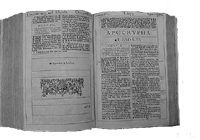 |

 Home
Home
 The Bible
The Bible
 Old Testament
Old Testament
 New Testament
New Testament
 The Canon
The Canon
 Prophecy
Prophecy
 Four Views
Four Views
 Revelation
Revelation
 Warnings
Warnings
 About Sin
About Sin
 Salvation
Salvation
 Authority
Authority
 Doctrine
Doctrine
|
 |
Non-Canonical
Books
The Apocryphal Books
The Roman Catholic Bible includes fifteen books not
included in the Protestant Canon. They are called the Apocryphal Books,
also known as the Deuterocanonical Books. They were approved in April 1546
by the Fourth Session of the Council of Trent for inclusion in the Roman
Catholic Canon. They consist of Judith, Tobit (Tobias), Baruch [of which
chapter 6 is the Letter of Jeremiah], 1 and 2 Maccabees, Ecclesiasticus
(Wisdom of Jesus Son of Sirach), additions to the book of Esther,
additions to the book of Daniel [The Prayer of Azariah and the song of the
Three Jews; Susanna; Bel and the Dragon], and the Wisdom of Solomon.
The Pseudopigrapha
Another set of writings called the Pseudopigrapha
consists of eleven writings - or more. These books are generally not
accepted in any canon. The Pseudopigrapha includes Enoch, The Assumption
of Moses, a fraction of the Apocalypse of Moses, 2 Baruch, 4 Ezra, the
Sibylline Oracles, Psalms of Solomon, The Book of Jubilees, The Books of
Adam and Eve, Life of Adam and Eve, The Martyrdom of Isaiah, The Letter of
Aristeas, The Apocalypse of Adam, The Revelation of Esdras, Joseph and
Aseneth, The Second Treatise of the Great Seth, The Testament of Abraham,
and others.
Reasons for Rejection
Protestant Bibles do not include either the
Apocryphal (Deuterocanonical) Books, nor the Pseudopigrapha. Some say
these books make interesting historical reading, but there is evidence
they contain historical error. Most protestant scholars reject these two
sets of books for the following reasons:
1. The Jews who originally received them did
not accept them as of Divine origin.
2. The N.T. never quotes from them, with two minor exceptions:
-
Jude 14 and 15 contains a quotation found in Enoch 1:9
-
Romans 1 parallels the Wisdom of Solomon chapter's 12 to 14 - but
contains no new teaching.
3. Jesus never quotes from them.
4. The doctrinal teaching in these books is aberrant - there is no
confirmation of their teachings anywhere in scripture.
-
Sin is treated lightly
-
Salvation is often treated as works
-
Angels are elevated and almost seem to be on a par with God
-
Miracles are fanciful with little historical certainty
5. It is difficult to ascertain their date of writing and
authorship. In the few cases where authors have been verified, they
never had the same standing as a canonical writer.
Canon
There are many things of note when it comes to the
Bible. One of the most important is how we got our canon. Canon is a word
that comes from the Greek language and it means 'gauge' or 'rule.'
Canonicity therefore is the gauge or rule by which we tell if a book is of
Divine origin and therefore part of the Bible. The sixty-six books in our
Bible did not become part of the canon of scripture by the will of man.
They were not inserted in our Bible because a committee examined them and
found that they 'measured up.'
There are sufficient copies of the original texts in
the original languages of the Bible to verify both the Old and New
Testament texts. Further, enough ancient translations of the Old and New
Testaments have survived to verify the Bible text. I believe the 66
books comprising the protestant Bible constitute the whole and complete
Word of God.
Top of Page
Home
|
 |
 |
 |

The Fourth Session of the Council of Trent had this
to say about the Bible, including the Deuterocanonical books: "If anyone
does not accept as sacred and canonical the aforesaid books in their
entirety and with all their parts, as they have been accustomed to be read
in the Catholic Church and as they are contained in the old Latin Vulgate
Edition, and knowingly and deliberately rejects the aforesaid traditions,
let him be anathema."
Protestants do not accept the Deuterocanonical books
as belonging in the canon.
|
 |
 |
|
 |

